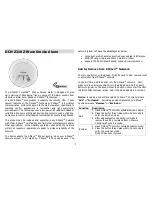
4
TESTING YOUR SMOKE DETECTOR
Test the detector weekly by pushing fi rmly on the test button with your fi nger until the horn
sounds. Testing method may take up to 20 seconds to sound the alarm horn. These are
only ways to be sure that detector is working correctly. If the detector fails to test properly,
have it repaired or replaced immediately.
WARNING:
Never use an open fl ame to test your detector. You may set fi re to damage
the detector, as well as your home. The built-in test switch accurately tests all
detector functions, as required by Underwriters’ Laboratories. They are the
only correct ways to test the unit.
WARNING:
When you are not testing the unit and the alarm horn sounds a loud
continuous sound, this means the detector has sensed smoke or combustion
particles in the air. Be sure that the alarm horn is a warning of a possible
serious situation, which requires your immediate attention.
• The alarm could be caused by a nuisance situation. Cooking smoke or a dusty furnace,
sometimes called “friendly fi res” can cause the alarm to sound. If this happens, open a
window or fan the air to remove the smoke or dust. The alarm will turn off as soon as the
air is completely clear.
• If the alarm horn begins to beep once a minute, this signal means that the detector’s
battery is weak. Replace new battery immediately. Keep fresh batteries on hand for this
purpose.
TAKING CARE OF YOUR SMOKE DETECTOR
To keep your detector in good working order, you must test the detector weekly, as
referring to section “TESTING YOUR SMOKE DETECTOR”.
• Replace the detector battery once a year or immediately when the low battery “beep”
signal sounds once a minute. The low battery “beep” should last at least 30 days.
NOTE:
For replacement battery , use Alkaline 9V
• Open the cover and vacuum the dust off the detector’s sensing chamber at least once
a year. This can be done when you open the detector to change the battery. Remove
battery before cleaning. To clean detector, use soft brush attachment to your vacuum.
Carefully remove any dust on detector components, especially on the openings of the
sensing chamber. Replace battery after cleaning. Test detector to make sure battery is
incorrectly. Check to make sure there are no obstruction inside the test button. If there is
any dust in the test button, insert a toothpick from the back to the front.
• Clean detector cover when it gets dirty. First open the cover and remove battery.
Hand-wash cover with cloth dampened with clean water. Dry it with lint-free cloth. Do not
get any water on the detector components. Replace the battery, and close cover. Test
detector to make sure that battery works correctly.





































